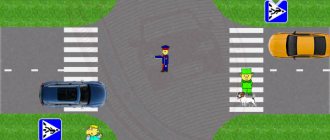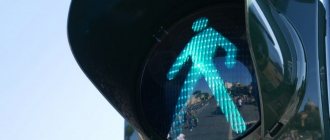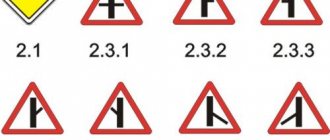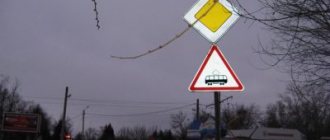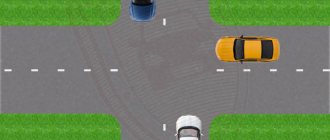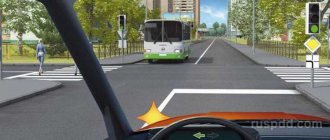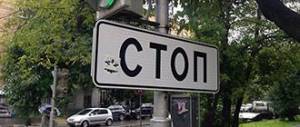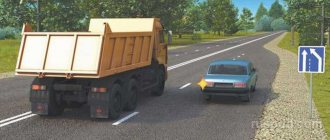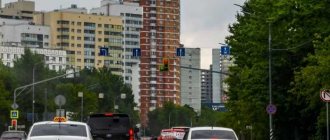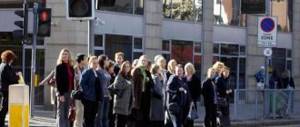Crosswalk
There are regulated and unregulated pedestrian crossings.
A controlled crossing can be recognized by the presence of a special pedestrian traffic light. Everyone knows perfectly well what he looks like. You need to cross such a crossing only when the signal is green. Not on red lights, not when there are no cars, not when you are in a hurry. Only on green! It’s better to wait a few seconds than to be hit by an unexpectedly driven car.
at the unregulated crossing . Paragraph 4.5 of the traffic rules states:
4.5. At unregulated pedestrian crossings, pedestrians can enter the roadway (tram tracks) after assessing the distance to approaching vehicles, their speed and making sure that the crossing will be safe for them.
Pay attention to how to cross the street. There is no need to jump out onto the road, thinking that everyone should immediately give way to you.
It happens that traffic is regulated by a traffic controller . You do not need to go out onto the road until the traffic controller gives you a special signal.
There are also overground and underground passages. But accidents happen extremely rarely in them; everyone knows how to cross them. The main thing is that if there is such a crossing, you need to use it and not run out onto the road.
Responsibilities of pedestrians
Pedestrians are required to move on specially equipped sidewalks. If there are none, it is allowed to walk along the side of the road, towards the traffic flow. Persons using wheelchairs or driving a bicycle or moped must walk in the same direction as cars.
In the dark, you must have reflective elements with you - stripes, keychains, badges, bracelets, etc.
Pedestrian crossing rules prohibit stopping on the roadway except in situations where it is related to road safety.
The rules allow you to stop on the dividing line if a person does not have time to cross to the opposite side. But on roads with heavy traffic, such a stop is unsafe both for the pedestrian and for drivers. Therefore, it is necessary to calculate the time before setting foot on the roadway.
When the transition is carried out by an organized group of people, two accompanying persons mark the beginning and end of the column. For these purposes, they are given red flags.
Crossroads - in the absence of a pedestrian crossing
There may not be a pedestrian crossing on the road. No problem. Section 4.3 of the traffic rules will help you
4.3. Pedestrians must cross the road at pedestrian crossings, including underground and overground ones, and in their absence, at intersections along sidewalks or curbs.
Pedestrians wonder what an intersection is and these mysterious lines of sidewalks and curbs. Look at the picture below, it shows the boundaries of the intersection and the places where you need to cross the road ( marked in yellow ).
In this case there are several nuances. If a pedestrian crosses the road at an intersection, then only those drivers who are turning left or right are required to give way to him.
Look at the drawing again. Pedestrians cross the road. The orange car turns left, the blue car turns right. They must give way. But the white car drives straight and has an advantage over pedestrians. I hope everything is clear.
Let's figure out why you need to cross the road at an intersection. When turning, the car always slows down, otherwise it simply won’t fit. At low speeds, it is much easier for the driver to notice a pedestrian and stop in time. After a turn, the car picks up speed again and its braking distance increases. This is some simple arithmetic.
How to cross the road correctly. Memo for children and parents
With the onset of summer holidays, there is a surge in road accidents involving children and teenagers. Since the beginning of the year, according to the traffic police of the Lipetsk region, more than 70 accidents involving children have occurred in the region, 78 children were injured, and three died. Moreover, 21 traffic accidents occurred at a pedestrian crossing, where 20 children were injured and two died. The reason is failure to comply with basic traffic rules.
Even the smallest child should know that the road can only be crossed in designated places: at a pedestrian crossing and at an intersection along the sidewalks or curbs. But even if this rule is observed, there is no guarantee of safety. Therefore, before going out onto the road, the child must stop at a distance of 50 cm - 1 meter from the edge of the roadway, look left and right, and only after making sure that there are no approaching cars, go out onto the roadway. You need to cross the road with a calm, measured step and under no circumstances run.
Unregulated pedestrian crossings pose a great danger to children. Here it is important to make sure that the distance to cars on both sides will allow the child to cross the road without stopping in the middle of the roadway. The child is also required to know traffic lights. He needs to explain that red and yellow traffic lights are prohibitive. It is especially dangerous to enter the road when the signal is yellow, as some cars complete the intersection and increase their speed at the same time. The green signal is permissive, but even in this case you need to look left and right and make sure that all the cars have stopped and there is no danger.
Children often find themselves under wheels when they get out of public transport and try to cross the road. Parents should explain to their child that passing a vehicle either in front or behind is dangerous. The fact is that it is large and nothing is visible because of it. You have to wait until the bus or trolleybus leaves.
Of particular concern are minor road users driving bicycles and motorcycles. In this regard, drivers of scooters (mopeds) must remember that, in accordance with the provisions of the Road Traffic Rules of the Russian Federation, persons at least 16 years of age are allowed to drive a vehicle of this category when driving on roads. In addition, clause 24.8 of the Traffic Rules prohibits driving on the road without a fastened motorcycle helmet.
Regularly remind your child of the basics of road safety, do not leave children unattended on the street and do not allow them to play near the roadway.
There is no crossing or crossroads
It may happen that there is no crossing or intersection on the road. There are such places. Point 4.3 will help you again:
If there is no crossing or intersection in the visibility zone, it is allowed to cross the road at right angles to the edge of the roadway in areas without a dividing strip and fences where it is clearly visible in both directions.
Almost everything is clear.
A fence is a fence in the middle of the road and the like. Look at the picture on the left. There is no need to climb over such fences.
You can also see the dividing strip
If there is neither a dividing strip nor a fence on the road, then you can cross it. However, you must give way to cars, i.e. wait until all the cars have passed.
Unregulated intersection
There is no traffic light at an unregulated intersection. Places where a pedestrian can cross the road are marked with special markings - “zebra crossings”. In addition, appropriate permit signs are installed on both sides of the road.
When crossing such an intersection, a pedestrian must make sure that the cars within sight have begun to slow down or have stopped completely. You can't go out on the road suddenly. You also need to make sure that drivers have a clear view. A parked car, a tree or bush, or another large object located near the side of the road can block a pedestrian.
The boundaries of a pedestrian crossing are indicated by markings and signs. You need to cross the road within the limits indicated by them.
Crossing the roadway even two meters from the crossing is considered a violation.
When the roadway is not equipped with either traffic lights or a zebra crossing, it is allowed to cross to the other side of the road at the intersection. The trajectory of movement must continue the line of the sidewalk (curb). It is prohibited to cross an unregulated intersection diagonally.
Additional information
It is strictly prohibited to cross the road at a red traffic light. After all, in such a situation, an accident will be inevitable. A car is a source of increased danger that cannot stop instantly.
In addition, if a pedestrian runs out onto the road in the wrong place and an accident occurs in which the driver, and not the pedestrian, receives minor or moderate injuries, then the latter faces administrative punishment in the form of a fine of one thousand to one and a half thousand rubles. So pedestrians need to be more careful.
What a pedestrian should know
Every person should read the “Rules of the Road” at least once in his life in order to know his rights and responsibilities as a pedestrian. There is no need to neglect this.
Where to cross the road? Only in places specifically designated for this purpose. In other words, only at regulated or unregulated pedestrian crossings. This must be remembered.
Benefits of pedestrians on the road
Pedestrians are endowed with certain responsibilities and rights, which periodically give them some advantage:
- A pedestrian has priority over a driver at an unregulated crossing.
- Regardless of whether the pedestrian has started his movement or has almost passed the crossing, the driver must stop until he comes to a complete stop and wait until he completes his journey.
- A pedestrian can change the direction of his movement in the middle of the road, so the driver needs to make sure that the pedestrian has completed his movement and is not going to go in the opposite direction or stop moving halfway.
- If a person is walking on the sidewalk near a crossing, the driver is not required to stop.
And also in section No. 14, the driver’s actions are described before a controlled crossing, when the green light is already on for the driver, and the pedestrian has not yet crossed the roadway. Here the driver needs to wait until the pedestrian finishes his journey and only then resume driving.
When moving along the extreme line of the road, pedestrians must move towards the traffic flow (left side). If people with limited physical capabilities in wheelchairs for the disabled and those who drive scooters, motorcycles and other two-wheeled vehicles move around there, the movement is organized in the direction of the traffic flow (right side).
How much is the fine for jaywalking?
The amount of penalties directly depends on the severity of the offense:
- the standard punishment for committing an offense will be a fine of 500 rubles
; - if the violator’s actions create obvious obstacles to traffic, then a fine of 1000 rubles
is issued under Part 1 of Art. 12.30 (the evidence base in this case may be weak, which reduces the frequency of application of sanctions); - if the unlawful actions of a pedestrian resulted in harm to the health of traffic participants of mild or moderate severity, then the amount of the fine can range from 1000 to 1500 rubles (Part 2 of Article 12.30)
.
Penalties are also provided for pedestrians who violate the rules for crossing the railway track. The fine in this case is 100 rubles.
With kids
Is it possible to cross the road in the wrong place if there is also a child next to an adult? Is it possible to risk the safety and life of the latter and cross the roadway where it is convenient? Of course not.
Moreover, every parent should first of all think about the safety and health of their child. Therefore, children should cross the road only in places designated for this purpose. Thus, if the pedestrian crossing is a little further away, then you need to walk to it.
In addition, when crossing the road with a child, be sure to hold his hand. A child should not be allowed to run out onto the road alone, even if there is a “Pedestrian Crossing” sign. It is very dangerous. After all, not all drivers follow traffic rules, and the driver may simply not have time to brake in front of a child running out onto the roadway.
Safety and compliance with traffic rules are paramount in this case.
Responsibility of pedestrians for traffic violations
Pedestrians are often personally responsible for an incident that occurs while crossing the roadway. The actions of a pedestrian are not always recognized as lawful. For this reason, increased care and responsibility on the roads can save your personal budget, and most importantly, life and health.
Liability in the form of an administrative fine or warning is imposed if unlawful actions:
- did not cause damage to health or create obstacles to traffic flow;
- disrupted normal traffic flow;
- led to minor harm to the victim's health.
Civil liability means that the culprit must compensate for the damage caused to the property, health, and moral condition of the victim.
Criminal liability arises if unlawful actions lead to the following consequences:
- Serious damage to health. The culprit may be limited in freedom (3 years or less), forced to perform forced labor (2 years or less), arrested (4 months or less), imprisoned (2 years or less).
- Death of the victim. In this situation, the freedom of the culprit may be limited (4 years or less), forced labor (4 years or less), or imprisonment (4 years or less).
The death of two or more persons is also included in this list. This case implies forced labor (5 years or less) or imprisonment (7 years or less).
Criminal penalty
Every person must cross the road at a pedestrian crossing. This is necessary for his own safety.
In the event that a pedestrian participant in the traffic decides to ignore this rule (runs out onto the roadway in a place where this is prohibited), and for this reason an accident occurs in which the driver of the car and his passengers receive serious injuries and injuries, then the pedestrian may face punishment under Article 268 of the Criminal Code.
The sanctions of this article provide for punishment even in the form of isolation from society for a period of up to two years. Therefore, pedestrians need to be more attentive and think not only about themselves, but also about the safety of other road users.
Existing sanctions
Where can you cross the road, and in what places is it strictly prohibited? Once again it is necessary to return to this issue.
You can cross the road:
- along pedestrian crossings (underground and overground);
- at intersections (where crossing the road is usually regulated by traffic lights);
- at right angles closer to the edge of the roadway, if there is no crossing nearby.
However, many pedestrians think that fines for violating traffic rules exist only for drivers. In fact, this is not true.
Crossing the road in the wrong place is punishable by a fine of five hundred rubles. Therefore, if a traffic police inspector notices a violating pedestrian, punishment will be inevitable.
If a person running across the road in the wrong place interferes with the movement of vehicles, he faces a fine of one thousand rubles. This must be taken into account.
About amendments to the law
Recently, certain amendments have been made to the traffic rules. Now drivers must “not let pass,” but “give way” to a pedestrian if he has entered the roadway and is walking along a zebra crossing. In other words, the person driving should not interfere with the driver’s movement.
If a driver violates this rule and does not give way to a pedestrian, he will face a fine of one and a half thousand rubles. But only if this offense is recorded on camera or noticed by a traffic police officer.

